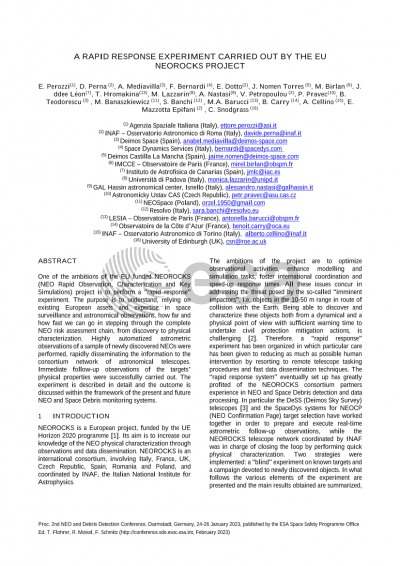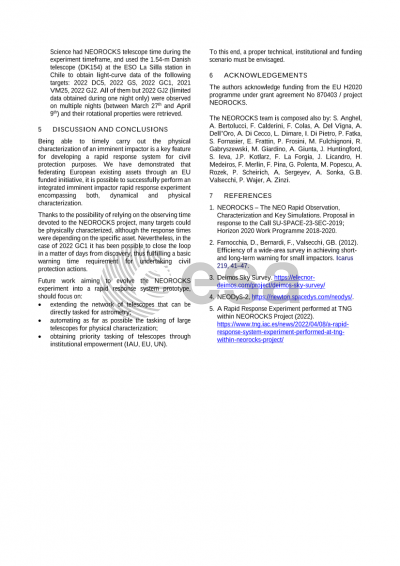Document details

Abstract
NEOROCKS (Near-Earth Object Rapid Observation, Characterization and Key Simulations) is an European project, funded by the Horizon 2020 UE program. Its aim is to increase our knowledge of the NEO physical characterization through observations and data dissemination. NEOROCKS is an international consortium, involving Italy, France, UK, Czech Republic, Spain, Romania and Poland, and coordinated by INAF. One of the project major objectives is to perform a “rapid response” experiment in order to understand, relying on existing European assets, how far and how fast we can go in stepping through the complete NEO risk assessment chain, from discovery to physical characterization. In doing so, particular care has been given to reducing as much as possible human intervention by resorting to remote telescope tasking procedures and fast data dissemination techniques. The “rapid response system” eventually set up has greatly profited of the NEOROCKS consortium partners experience in both, NEO and Space Debris detection and data processing. In particular the DESS (Deimos Sky Survey) telescopes and the SpaceDys systems for NEOCP target selection have worked together in order to prepare and execute real-time astrometric follow-up observations, while the NEOROCKS telescope network coordinated by INAF was in charge of closing the loop by performing quick physical characterization. Two strategies were implemented: a “blind” experiment on known targets as well as rapid response campaigns aimed at newly discovered objects. In the night between 3rd and 4th of April 2022, highly automatized astrometric observations of a sample of newly discovered NEOs have been carried out, rapidly disseminating the information within the NEOROCKS consortium in order to perform quick follow-up observations of the targets’ physical properties. Among the observed targets, asteroid 2022 GC1 has been the subject of a DDT (Director Discretionary Time) request to TNG (Telescopio Nazionale Galileo, Canary islands). Observations have been activated in the night between April 5th and 6th, and standard BVRI photometry successfully obtained. At the time of observations, 2022 GC1 was at 1.1 au from the Sun and 0.12 au from our planet. It is noteworthy that both astrometric and physical follow-up observations were completed in a matter of days, a promising figure for facing the imminent impactors problem, especially considering that at present for civil protection purposes the day of re-entry of a large infrastructure such as Tiangong-1 can be predicted only 3 days in advance. The above rapid response experiment will be presented in detail and its relevance within the framework of the present and future Planetary Defence programmes will be discussed. Recommendations toward a roadmap for NEO physical characterization will also be laid down.
* The NEOROCKS Team is composed also by: S. Anghel, A. Bertolucci, F. Calderini, F. Colas, A. Del Vigna, A. Dell’Oro, A. Di Cecco, L. Dimare, I. Di Pietro, P. Fatka, S. Fornasier, E. Frattin, P. Frosini, M. Fulchignoni, R. Gabryszewski, M. Giardino, A. Giunta, J. Huntingford, J.P. Kotlarz, F. La Forgia, J. Licandro, H. Medeiros, F. Merlin, F. Pina, G. Polenta, M. Popescu, A. Rozek, P. Scheirich, A. Sergeyev, A. Sonka, C. Snodgrass, G.B. Valsecchi, P. Wajer, A. Zinzi
Preview





